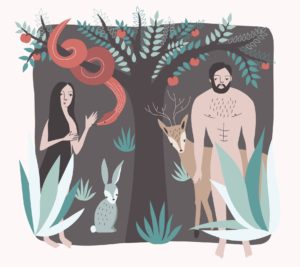
If you were raised in a Christian family, you probably heard about the Adam and Eve story in Sunday school or during church sermons. Perhaps these lessons warned about the perils of disobedience, explained original sin or unfortunately promoted traditional patriarchal gender roles. However, one controversial theory about the origins of the Bible’s “first couple” may shock some while also shedding a light on ancient Middle Eastern mythology.
Examining Biblical Authorship and Interpretations
To understand how scholars, theologians and even laypeople arrive at their readings of religious texts, it’s important to know a little about the methods they use. One such technique is known as “historical criticism,” which looks to outside sources to derive a writing’s meaning and possible purpose. Oxford Biblical Studies Online details how this process is commonly employed:
- Examining the text to confirm its authenticity
- Determining its probable authorship, if possible
- Comparing its narrative with external documents and archeological finds
Christian Fundamentalism and Biblical Literalism
The historical-critical method gained popularity during the 19th and 20th centuries. Meanwhile, the Encyclopedia Britannica explains that Charles Darwin’s theory of evolution called the Genesis creation accounts into question. Seeing these as threats to their faith, some Christian thinkers developed ideas that would later contribute to fundamentalist theologies.
Building from Martin Luther’s doctrine of sola Scriptura or “Scripture alone,” scholars at Princeton Theological Seminary argued that the Bible should be considered both infallible and inerrant, serving as a correct authority on matters of morals and faith as well as scientific and historical facts. For this reason, many fundamentalist Christian thinkers reject historical-critical interpretations of scripture, insisting that these refute authoritative stances based on the Bible and its “divinely inspired” nature.
Adam, Eve and Canaanite Mother Goddess Worship
The New World Encyclopedia reveals a potentially startling theory about the origins of the Adam and Eve narrative from the second and third chapters of Genesis, divulging three major conclusions reached about the story by scholars using the historical-critical method:
- These chapters were likely penned during King Solomon’s reign, around the 10th century B.C.E.
- The author promoted a Yahweh-based religion that excluded other deities
- The narrative criticizes Canaanite mother goddess worship
Asherah was a significant mother goddess figure in the ancient Middle East. While the Encyclopedia Britannica elucidates that she was usually considered the wife of El or a consort of Baal, she was also at times revered as a consort of Yahweh. Rituals often focused on gaining her blessings for adequate rain and good crops, invoking a sacred joining of masculine and feminine forces through intercourse with temple priestesses.
Some scholars speculate that the Yahwist author may have adopted Asherah’s symbols, gifting them with negative meanings. Serpents were used to represent the goddess, so the writer might have introduced a deceitful serpent who lies to Eve and convinces her to disobey God. Furthermore, God is depicted as warning the first humans against eating the fruit of “the tree of the knowledge of good and evil.” Trees or poles were also associated with Asherah, and “the knowledge of good and evil” may have had sexual connotations to ancient Middle Eastern readers. Finally, Eve’s name itself may hold some clues. In the original text, Eve’s name is “Haw-wah,” which translates to “living,” but some texts about Asherah address the goddess as “Lady Ḥawwat.”
What Are the Ramifications?
While the Adam and Eve story has been given a variety of interpretations, it’s possible that the author wrote it as a polemically influenced attack on pagan mother goddess worship. This individual may have used Asherah’s symbols, inverting their meanings to craft a narrative of sin, destruction and death. Whether or not one accepts this possible meaning behind this passage, the presence of pagan elements in the story’s creation may have interesting impacts on the modern Christian faith.

